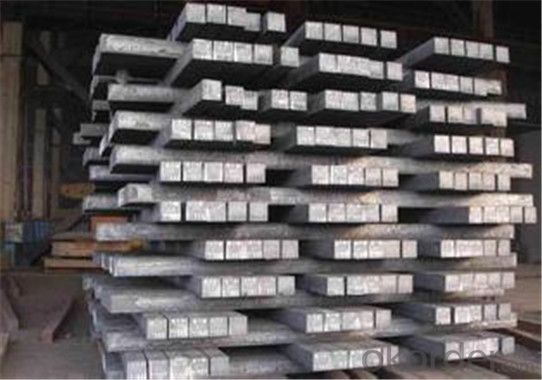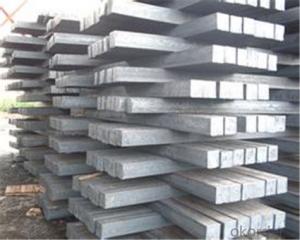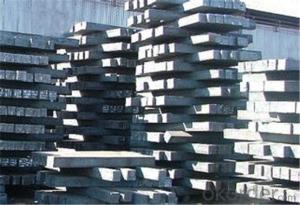Square Steel Billets Hot Sale Deformed Billet Q275/3SP in China
- Loading Port:
- Tianjin
- Payment Terms:
- TT OR LC
- Min Order Qty:
- 400 m.t.
- Supply Capability:
- 45555555 m.t./month
OKorder Service Pledge
OKorder Financial Service
You Might Also Like
Item specifice
Description of steel billet:
We procure world class quality steel billets which meets the specific requirements of the clients
The Billets produced by the company can be broadly divided into three main types i.e.
Festures of steel billet:
Billets are used for rolling of TMT Re-Bars of Fe415 and Fe500 Grade and various other structural steel products. Billets are used fro rolling of CRS TMT Re-Bars..
Specifications of steel billet:
Type | Steel billet / Square steel/ Steel square bar |
Standard grade | 3SP/PS, 5SP/PS, Q195, Q235, Q255, Q275, 20MnSi etc. |
MOQ | 1000 MT |
Technique | Hot rolled |
Size | 50*50mm ~ 160*160mm |
Length | 3~12m |
Packing | Loose packing, in bundle |
Payment terms | T/T, L/C at sight, Usance L/C |
Trade terms | EXW, FOB, CFR, CIF |
Trans terms | FIO, FILO, FLT |
Inspection | Third party inspection accepted |
Delivery time | 15-30 days, according to the quantity |
Applications | carbon structural steel, wire rod, rod, deformed bars, profile steel, machine parts, and steel moulds etc . |
Note | Customized service is available (for sizes,length and chemical components etc.). |
Images of steel billet:

FAQ:
1. What is your package?
Packing situation: standard seaworthy packing or as customer required.
2. How long is the lead time?
Delivery time: 45 days after order confirmed.
3. What payment term do you accept?
Payment: T/T or L/C at sight.
- Q:How are steel wire rods used in the manufacturing of bicycle spokes?
- Bicycle spokes heavily rely on steel wire rods, which are pivotal in their production. Typically, these wire rods are crafted from top-notch steel and undergo a series of processes to attain the desired strength and flexibility required for spokes. To commence, meticulous selection and inspection of the steel wire rods are carried out to identify any imperfections or defects. Once the quality check is completed, the rods undergo a thorough cleaning and straightening process to ensure they are devoid of any debris or bends that may jeopardize their structural integrity. Subsequently, the wire rods are precisely cut into lengths that are determined based on the specific measurements required for the bicycle spokes. These measurements are typically based on the size and design of the bicycle wheel. Following the cutting process, the wire rods undergo a crucial procedure called swaging, wherein the diameter of the rod's ends is reduced. This swaging process is of utmost importance as it facilitates the creation of a tapered shape that allows for effortless insertion into the hub and rim of the bicycle wheel. Upon completion of the swaging process, the wire rods are then threaded at one end. This threading is indispensable as it enables the attachment of the spoke nipple, which connects the spoke to the wheel rim. Lastly, the wire rods are treated with a protective coating, such as zinc plating, to enhance their corrosion resistance and ensure their durability. This coating not only increases the longevity of the spokes but also adds an aesthetic appeal. In conclusion, steel wire rods play an indispensable role in the manufacturing of bicycle spokes. Through the selection, cleaning, straightening, cutting, swaging, threading, and coating processes, spokes that are strong, flexible, and corrosion-resistant are created. These spokes are a vital component in ensuring the structural integrity and smooth operation of bicycle wheels.
- Q:How does the brittleness of steel wire rod vary with different wire drawing processes?
- The brittleness of steel wire rod can vary with different wire drawing processes. Wire drawing is a metalworking process used to reduce the diameter of a wire by pulling it through a series of dies. The specific wire drawing process used can have a significant impact on the final properties of the wire, including its brittleness. One factor that affects the brittleness of steel wire rod is the reduction in area during the wire drawing process. The reduction in area refers to the amount of material that is removed from the wire as it is drawn through the dies. Higher reductions in area result in a greater degree of deformation and strain on the wire, which can lead to increased brittleness. This is because the grain structure of the steel becomes more elongated and aligned, making it more susceptible to cracking and breaking under stress. Another factor that influences the brittleness of steel wire rod is the speed at which the wire is drawn. Higher drawing speeds can create higher levels of strain and deformation in the wire, which can increase its brittleness. Rapid cooling of the wire during the drawing process can also contribute to brittleness, as it can lead to the formation of brittle phases in the steel microstructure. Furthermore, the heat treatment applied to the wire after the drawing process can also impact its brittleness. Heat treatment processes, such as annealing, can help to relieve internal stresses and improve the ductility of the wire, thereby reducing its brittleness. On the other hand, improper heat treatment or inadequate cooling can result in increased brittleness. In summary, the brittleness of steel wire rod can vary with different wire drawing processes. Factors such as the reduction in area, drawing speed, cooling rate, and heat treatment all play a role in determining the final brittleness of the wire. It is essential for manufacturers to carefully control these parameters to achieve the desired mechanical properties in the wire.
- Q:How is steel wire rod used in the production of wire for wire rope slings?
- Steel wire rod is a crucial component in the production of wire for wire rope slings. Wire rod is the raw material that is used to manufacture the wire ropes, which are then used in the production of wire rope slings. Wire rod is first processed through a series of manufacturing steps to transform it into wire ropes. These steps include drawing, stranding, and closing the wire ropes. The wire rod is initially drawn through a die to reduce its diameter and increase its length. This process helps to improve the strength and flexibility of the wire. After the drawing process, the wire rod is then stranded, which involves twisting multiple wires together to form a strand. Several strands are then twisted together to form the wire rope. This stranding process provides additional strength and durability to the wire rope, making it suitable for heavy-duty applications. Finally, the wire rope is closed by using specialized machinery to form a loop or an eye on one or both ends. This closure ensures that the wire rope can be securely attached to equipment or structures, allowing for safe lifting and handling. Overall, steel wire rod is an essential material in the production of wire for wire rope slings. It undergoes various manufacturing processes to transform it into wire ropes that possess high strength, flexibility, and durability. These wire ropes are then used in the construction of wire rope slings, which are widely employed in lifting and rigging operations across various industries.
- Q:How is steel wire rod transported from the manufacturing plant to the customer?
- Transporting steel wire rods involves various modes of transportation, depending on the distance and requirements. To ensure safe delivery, the transportation process consists of multiple stages. Typically, steel wire rods are packaged in coils or bundles for easy handling and transportation. These are then loaded onto trucks or railway wagons at the manufacturing plant. For shorter distances, trucks are commonly used, while railways are preferred for longer distances due to their larger carrying capacity. For international shipments, cargo ships are often used. These ships have specialized containers or cargo holds to securely accommodate the coils or bundles. The steel wire rods are carefully loaded and secured to prevent any movement during transit. Additionally, cargo ships provide protection against weather conditions and potential damage. During transportation, customs clearance procedures may be necessary, especially for international shipments. This ensures compliance with import regulations and documentation requirements. The process may involve inspections, document verification, and payment of duties or taxes. Upon arrival at the destination port or terminal, the steel wire rods are unloaded from the cargo ship and transferred to trucks or trains for further transportation to the customer's location. Depending on requirements, the coils or bundles may be temporarily stored in warehouses or distribution centers before final delivery. Throughout the entire transportation process, careful handling is crucial to prevent damage or deformations. Proper securing and handling techniques are employed to maintain the integrity of the product, as any damage can impact its quality and usability. In conclusion, steel wire rods are transported through trucks, railways, and cargo ships, depending on distance and requirements. The coils or bundles are loaded, secured, and transported with utmost care to ensure safe delivery.
- Q:What are the advantages of using steel wire rod over other materials?
- Steel wire rod offers numerous advantages compared to other materials. Firstly, its exceptional strength and durability make it ideal for applications requiring reliability. It can withstand heavy loads and stresses, making it suitable for industries such as construction, automotive, and manufacturing. Secondly, steel wire rod is highly versatile as it can be easily fabricated into various shapes and sizes to meet specific project requirements. This flexibility allows for a wide range of applications, including wire ropes, springs, cables, fencing, and reinforcement in concrete structures. Moreover, steel wire rod exhibits excellent corrosion resistance properties, ensuring a longer lifespan and reduced maintenance costs. This makes it suitable for outdoor and marine applications, where exposure to moisture and harsh weather conditions is common. Additionally, steel wire rod is cost-effective due to its abundance and widespread availability. Its durability and resistance to wear and tear also contribute to lower replacement and maintenance costs in the long run. Lastly, steel wire rod promotes environmental sustainability as steel is one of the most recycled materials globally. Using steel wire rod helps conserve natural resources and reduce carbon emissions by reducing the need for new production. In summary, the advantages of steel wire rod include its exceptional strength, versatility, corrosion resistance, cost-effectiveness, and environmental sustainability. These qualities make it a preferred choice for a wide range of applications across different industries.
- Q:How is steel wire rod used in the manufacturing of automotive suspension springs?
- Steel wire rod is used in the manufacturing of automotive suspension springs as it provides the necessary strength and flexibility required to withstand the weight and movement of a vehicle. By being coiled and formed into the desired shape, the steel wire rod serves as the main component of the suspension spring, allowing it to absorb and dampen shocks and vibrations, ensuring a smooth and stable ride for the vehicle.
- Q:How is steel wire rod used in the manufacturing of wire rope shackles?
- Steel wire rod is a primary raw material used in the manufacturing of wire rope shackles. It is first processed into wire by drawing it through a series of dies to reduce its diameter. This wire is then further processed, typically by forging or machining, to create the individual components of the wire rope shackles, such as the body, pin, and clevis. These components are then assembled and secured using various techniques, including welding or threaded connections, to form the final wire rope shackles.
- Q:What are the recent developments and innovations in steel wire rod production?
- Recent developments and innovations in steel wire rod production include the use of advanced technologies such as continuous casting and direct rolling, which improve the quality and efficiency of the production process. Additionally, there has been a focus on developing new alloys and coatings to enhance the strength, durability, and corrosion resistance of steel wire rods. Furthermore, automation and digitization have been introduced to optimize the production line, reduce energy consumption, and minimize waste. Overall, these advancements aim to meet the increasing demands of various industries and ensure the production of high-quality steel wire rods.
- Q:What are the common applications of bright and oil tempered steel wire rod?
- Bright and oil tempered steel wire rods have a wide range of applications due to their unique properties. Some of the common applications of these wire rods include: 1. Springs: Bright and oil tempered steel wire rods are extensively used in the manufacturing of springs. These wire rods offer excellent tensile strength and durability, making them ideal for applications where springs need to withstand high levels of stress and repetitive motion. 2. Wire ropes: Bright and oil tempered steel wire rods are commonly used in the production of wire ropes. These wire rods provide high strength and resistance to wear and abrasion, making them suitable for applications that require lifting, pulling, or carrying heavy loads. 3. Wire mesh: Bright and oil tempered steel wire rods are also utilized in the production of wire mesh. Wire mesh made from these wire rods is widely used in construction, agriculture, and industrial settings for fencing, security, and reinforcement purposes. 4. Automotive industry: Bright and oil tempered steel wire rods find extensive use in the automotive industry. They are used in the manufacturing of various components such as suspension springs, seat springs, engine valve springs, and tire reinforcements. The high strength and fatigue resistance of these wire rods make them essential for ensuring the safety and performance of automotive products. 5. Construction industry: Bright and oil tempered steel wire rods are commonly employed in the construction industry for various applications. They are used in the production of reinforcing bars (rebars) that are essential for strengthening concrete structures. Additionally, these wire rods are used for wire mesh used in concrete reinforcement, as well as in the production of nails, screws, and other fasteners. 6. Furniture manufacturing: Bright and oil tempered steel wire rods are widely used in the production of furniture, particularly in the construction of springs for mattresses, sofas, and chairs. The flexibility and durability of these wire rods ensure optimal comfort and longevity in furniture products. Overall, bright and oil tempered steel wire rods are versatile materials that find applications in numerous industries. Their high strength, durability, and flexibility make them suitable for various demanding applications, providing essential support and reinforcement in a wide range of products.
- Q:What is the standard length of steel wire rod?
- The standard length of steel wire rod can vary depending on the specific industry and application. Generally, steel wire rods are produced in lengths ranging from 5.5 meters to 12 meters. However, it is important to note that customized lengths can also be produced according to the requirements of the customer. The length of the steel wire rod is determined by factors such as the intended use, manufacturing process, and transportation logistics.
1. Manufacturer Overview |
|
|---|---|
| Location | |
| Year Established | |
| Annual Output Value | |
| Main Markets | |
| Company Certifications | |
2. Manufacturer Certificates |
|
|---|---|
| a) Certification Name | |
| Range | |
| Reference | |
| Validity Period | |
3. Manufacturer Capability |
|
|---|---|
| a)Trade Capacity | |
| Nearest Port | |
| Export Percentage | |
| No.of Employees in Trade Department | |
| Language Spoken: | |
| b)Factory Information | |
| Factory Size: | |
| No. of Production Lines | |
| Contract Manufacturing | |
| Product Price Range | |
Send your message to us
Square Steel Billets Hot Sale Deformed Billet Q275/3SP in China
- Loading Port:
- Tianjin
- Payment Terms:
- TT OR LC
- Min Order Qty:
- 400 m.t.
- Supply Capability:
- 45555555 m.t./month
OKorder Service Pledge
OKorder Financial Service
Similar products
New products
Hot products
Related keywords



























